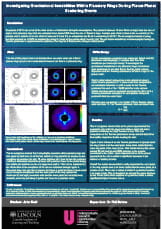by Jake Muff
 For this project we looked at the J1407 star system which is approximately 434 light years from Earth. The system consists of the Star which is about 90% of the mass of the Sun and the exoplanet, which is approximated to have between 13 and 26 Jupitar masses with an extensive ring system (640 times the extent of Saturn’s rings!). The most unique thing about this system though is its eccentricity. With an eccentric orbit estimated to be around 0.6 which is a highly eccentric orbit when compared to the Earth’s 0.0167!
For this project we looked at the J1407 star system which is approximately 434 light years from Earth. The system consists of the Star which is about 90% of the mass of the Sun and the exoplanet, which is approximated to have between 13 and 26 Jupitar masses with an extensive ring system (640 times the extent of Saturn’s rings!). The most unique thing about this system though is its eccentricity. With an eccentric orbit estimated to be around 0.6 which is a highly eccentric orbit when compared to the Earth’s 0.0167!
J1407b is the first exoplanet to be discovered with a ring system by transit method, therefore allowing us the unique opportunity to help everyday research with this project. The aim of this project was to understand how eccentric orbits can affect a planets ring system and to understand if this allows for moons to form in the planetary ring.
The project started off with a lot (and I mean a lot!) of planning and reading, which wasn’t a great start, but it had to be done. My supervisor had provided me with some data at the start of the project in the form of ‘snapshots’ which were basically data from the simulated orbit of the system, taken at a specific time or snapshot. Using these snapshots provided I used IDL to perform calculations and Splash to visualise my calculations and data. The goal was to calculate a Toomre parameter, which showed individual stability of each of the 10,000 particles in the system, which was used at different snapshots and compared.
I found the outer parts of the ring system at all points in time were generally a lot more stable than the inner regions. The regions closest to the exoplanet were the most unstable and had the highest Toomre values, however this can be explained by the Roche Limit, which is the inner boundary after which particles are so close to the planet that they experience strong tidal forces.
Using later time frames, I found that the outer parts of the ring system became more unstable. Which can be explained by the planet coming closer to the Star throughout its orbit with the particles furthest away from the planet being most affected by the gravity of the star.
In reflection, this project was tough, however I learnt an immense amount from it. It was hard in the sense that it was a level of independence I had not yet experienced at university as I had to read up on something I’ve never heard about before, plan out the project myself and learn a new computer language then use it for my programs.
This project taught me a lot about myself and how I can best complete a task that I have set for myself as well as how to overcome problems and issues independently without asking for help. This project has also given me an insight into the world of research and allowed me to learn what it’s like.
*To view Jake’s project poster, please click on the thumbnail below:

